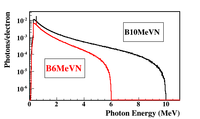Difference between revisions of "G4Beamline PbBi"
| Line 10: | Line 10: | ||
[[Niowave_Report_11-30-2015]] | [[Niowave_Report_11-30-2015]] | ||
| + | |||
| + | |||
| + | deadline 4/12/16 | ||
| + | |||
| + | |||
| + | ==Niowave_9-2015== | ||
| + | ==Niowave_10-2015== | ||
| + | ==Niowave_11-2015== | ||
| + | ==Niowave_12-2015== | ||
| + | ==Niowave_1-2016== | ||
| + | ==Niowave_2-2016== | ||
| + | ==Niowave_3-2016== | ||
| + | ==Niowave_4-2016== | ||
| + | ==Niowave_5-2016== | ||
| + | ==Niowave_6-2016== | ||
| + | |||
=Task List= | =Task List= | ||
Revision as of 17:15, 12 April 2016
Development of a Positron source using a PbBi converter and a Solenoid
Conclusions
- A 0.3 (0.6) Tesla Solenoid with a diameter to allow a 9.74 (3.94) cm diameter pipe would collect a positron per thousand incident electrons on a 2mm thick LBE target with 0.25 mm thick SS windows.
- A 15 cm long, 0.2 Tesla solenoid with a 3.94 diameter beam pipe would collect a positron per two thousand electrons impinging a 2mm thick LBE target with 0.25 mm thick SS windows.
- A 4 Tesla Solenoid will remove beam pipe heating from scattered electrons downstream of the target when using a 3.94 cm diameter beam pipe.
Reports
deadline 4/12/16
Niowave_9-2015
Niowave_10-2015
Niowave_11-2015
Niowave_12-2015
Niowave_1-2016
Niowave_2-2016
Niowave_3-2016
Niowave_4-2016
Niowave_5-2016
Niowave_6-2016
Task List
1.) Create a positron (10,000 positrons) and electron event file containing t,x,y,z,Px,Py,Pz for positrons exiting the solenoid and an incident Gaussian beam 1cm in diameter and with a sigma of 1cm.
compare distributions with and without solenoid.
2.) Determine the back ground when using a 3.48 diameter beam pipe and Solenoid field of 0.2 for a NaI detector placed at
3.) Experiment, install dipole and solenoid in the tunnel.
Beam Pipe Heating
Converter target properties
PbBi_NioWave_TargetProperties_2015
Target thickness optimization
PbBi_THickness_CylinderBeam
PbBi_THickness_GaussBeam
PbBi_THickness_PntSource
Solenoid
Uniform ideal Solenoid
PbBi_BeamPipeHeating_w_Solenoid_2015
PbBi_60cmLong_Solenoid_Collection_Efficiency_2015
Positron & Electron event files
PbBi_PosEventFiles_VaccumGaps_2015
PbBi_PosEventFiles_NoGaps_2016
Solenoid Map
Inner Radiusu=
Outer Radius =
Length =
Current=
Magnetic Field Map in cylindrical coordinates (Z & R) from Niowave
Rear Window Thickness
Question: Will a thicker downstream exit window increase the positron production efficiency by providing more material for a brehm photon to pair produce in?
Positrons were counted exiting a ideal 0.2 Tesla solenoid that was 15 cm long. A ten MeV electron beam with a 0.5 cm cylindrical radius impinged a 2mm thick PbBi liquid target that had a surface area of 2.54 cm x 2.54 cm. A 0.25 mm thick stainless steel entrance window was used.
Target is at -106 mm, entrance SS window is at -108.25 mm , exit SS window is at -103.75 mm, A sensitive detector for positron is placed at Z= +44mm. The sensitive detector is a cylinder of radius 11.74 cm.
| SS Exit WIndow Thickness (mm) | Positrons/Million electrons |
| 0.0 | 1142,1096,1149,1073,1083 = 1109 +/- 35 |
| 0.25 | 774,836,800,785,798 = 798 +/- 23 |
| 0.5 | 693,704,713,697,715 = 704 +/- 10 |
| 1.0 | 587,606,548,592,550 =577 +/- 26 |
- Conclusion 1
- Positron production efficiency improves when the exit window is made thinner
- Conclusion 2
- You loose about 28 +/- 4 % of the positrons in the 0.25 mm thick SS exit window.
Background studies
Brem Spectrum
Below is the photon energy distribution (from Brem & pair production) using a 2mm Pb target for two different incident electron energies; 6 and 10 MeV. The photons are 1 cm downstream of the target and intersection a large forward region.
insert photon spacial distributions
Now mow the scoring region downstream to a position representing the location of a NaI detector.
